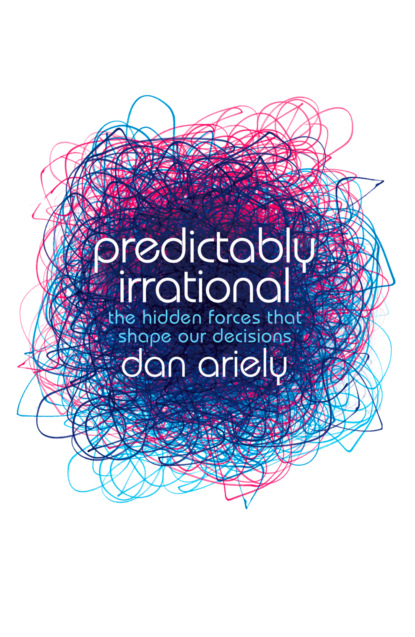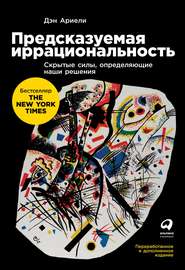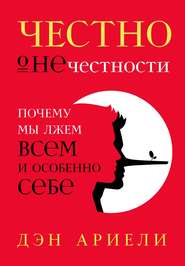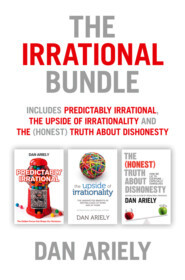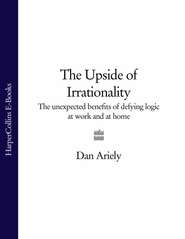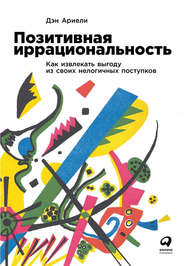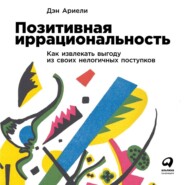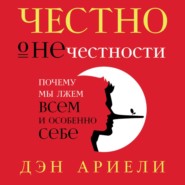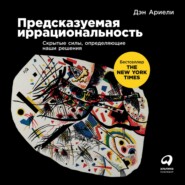По всем вопросам обращайтесь на: info@litportal.ru
(©) 2003-2024.
✖
Predictably Irrational
Автор
Год написания книги
2018
Настройки чтения
Размер шрифта
Высота строк
Поля
But if our choices are often affected by random initial anchors, as we observed in our experiments, the choices and trades we make are not necessarily going to be an accurate reflection of the real pleasure or utility we derive from those products. In other words, in many cases we make decisions in the marketplace that may not reflect how much pleasure we can get from different items. Now, if we can't accurately compute these pleasure values, but frequently follow arbitrary anchors instead, then it is not clear that the opportunity to trade is necessarily going to make us better off. For example, because of some unfortunate initial anchors we might mistakenly trade something that truly gives us a lot of pleasure (but regrettably had a low initial anchor) for something that gives us less pleasure (but owing to some random circumstances had a high initial anchor). If anchors and memories of these anchors – but not preferences – determine our behavior, why would trading be hailed as the key to maximizing personal happiness (utility)?
SO, WHERE DOES this leave us? If we can't rely on the market forces of supply and demand to set optimal market prices, and we can't count on free-market mechanisms to help us maximize our utility, then we may need to look elsewhere. This is especially the case with society's essentials, such as health care, medicine, water, electricity, education, and other critical resources. If you accept the premise that market forces and free markets will not always regulate the market for the best, then you may find yourself among those who believe that the government (we hope a reasonable and thoughtful government) must play a larger role in regulating some market activities, even if this limits free enterprise. Yes, a free market based on supply, demand, and no friction would be the ideal if we were truly rational. Yet when we are not rational but irrational, policies should take this important factor into account.
CHAPTER 3
The Cost of Zero Cost
Why We Often Pay Too Much When We Pay Nothing
Have you ever grabbed for a coupon offering a FREE! package of coffee beans – even though you don't drink coffee and don't even have a machine with which to brew it? What about all those FREE! extra helpings you piled on your plate at a buffet, even though your stomach had already started to ache from all the food you had consumed? And what about the worthless FREE! stuff you've accumulated – the promotional T-shirt from the radio station, the teddy bear that came with the box of Valentine chocolates, the magnetic calendar your insurance agent sends you each year?
It's no secret that getting something free feels very good. Zero is not just another price, it turns out. Zero is an emotional hot button – a source of irrational excitement. Would you buy something if it were discounted from 50 cents to 20 cents? Maybe. Would you buy it if it were discounted from 50 cents to two cents? Maybe. Would you grab it if it were discounted from 50 cents to zero? You bet!
What is it about zero cost that we find so irresistible? Why does FREE! make us so happy? After all, FREE! can lead us into trouble: things that we would never consider purchasing become incredibly appealing as soon as they are FREE! For instance, have you ever gathered up free pencils, key chains, and notepads at a conference, even though you'd have to carry them home and would only throw most of them away? Have you ever stood in line for a very long time (too long), just to get a free cone of Ben and Jerry's ice cream? Or have you bought two of a product that you wouldn't have chosen in the first place, just to get the third one for free?
ZERO HAS HAD a long history. The Babylonians invented the concept of zero; the ancient Greeks debated it in lofty terms (how could something be nothing?); the ancient Indian scholar Pingala paired zero with the numeral 1 to get double digits; and both the Mayans and the Romans made zero part of their numeral systems. But zero really found its place about AD 498, when the Indian astronomer Aryabhata sat up in bed one morning and exclaimed, “Sthanam sthanam dasa gunam”—which translates, roughly, as “Place to place in 10 times in value.” With that, the idea of decimal-based place-value notation was born. Now zero was on a roll: It spread to the Arab world, where it flourished; crossed the Iberian Peninsula to Europe (thanks to the Spanish Moors); got some tweaking from the Italians; and eventually sailed the Atlantic to the New World, where zero ultimately found plenty of employment (together with the digit 1) in a place called Silicon Valley.
So much for a brief recounting of the history of zero. But the concept of zero applied to money is less clearly understood. In fact, I don't think it even has a history. Nonetheless, FREE! has huge implications, extending not only to discount prices and promotions, but also to how FREE! can be used to help us make decisions that would benefit ourselves and society.
If FREE! were a virus or a subatomic particle, I might use an electron microscope to probe the object under the lens, stain it with different compounds to reveal its nature, or somehow slice it apart to reveal its inner composition. In behavioral economics we use a different instrument, however, one that allows us to slow down human behavior and examine it frame by frame, as it unfolds. As you have undoubtedly guessed by now, this procedure is called an experiment.
IN ONE EXPERIMENT, Kristina Shampanier (a PhD student at MIT), Nina Mazar (a professor at the University of Toronto), and I went into the chocolate business. Well, sort of. We set up a table at a large public building and offered two kinds of chocolates – Lindt truffles and Hershey's Kisses. There was a large sign above our table that read, “One chocolate per customer.” Once the potential customers stepped closer, they could see the two types of chocolate and their prices.[10 - We posted the prices so that they were visible only when people got close to the table. We did this because we wanted to make sure that we did not attract different types of people in the different conditions – avoiding what is called self-selection.]
For those of you who are not chocolate connoisseurs, Lindt is produced by a Swiss firm that has been blending fine cocoas for 160 years. Lindt's chocolate truffles are particularly prized – exquisitely creamy and just about irresistible. They cost about 30 cents each when we buy them in bulk. Hershey's Kisses, on the other hand, are good little chocolates, but let's face it, they are rather ordinary: Hershey cranks out 80 million Kisses a day. In Hershey, Pennsylvania, even the streetlamps are made in the shape of the ubiquitous Hershey's Kiss.
So what happened when the “customers” flocked to our table? When we set the price of a Lindt truffle at 15 cents and a Kiss at one cent, we were not surprised to find that our customers acted with a good deal of rationality: they compared the price and quality of the Kiss with the price and quality of the truffle, and then made their choice. About 73 percent of them chose the truffle and 27 percent chose a Kiss.
Now we decided to see how FREE! might change the situation. So we offered the Lindt truffle for 14 cents and the Kisses free. Would there be a difference? Should there be? After all, we had merely lowered the price of both kinds of chocolate by one cent.
But what a difference FREE! made. The humble Hershey's Kiss became a big favorite. Some 69 percent of our customers (up from 27 percent before) chose the FREE! Kiss, giving up the opportunity to get the Lindt truffle for a very good price. Meanwhile, the Lindt truffle took a tumble; customers choosing it decreased from 73 to 31 percent.
What was going on here? First of all, let me say that there are many times when getting FREE! items can make perfect sense. If you find a bin of free athletic socks at a department store, for instance, there's no downside to grabbing all the socks you can. The critical issue arises when FREE! becomes a struggle between a free item and another item – a struggle in which the presence of FREE! leads us to make a bad decision. For instance, imagine going to a sports store to buy a pair of white socks, the kind with a nicely padded heel and a gold toe. Fifteen minutes later you're leaving the store, not with the socks you came in for, but with a cheaper pair that you don't like at all (without a padded heel and gold toe) but that came in a package with a FREE! second pair. This is a case in which you gave up a better deal and settled for something that was not what you wanted, just because you were lured by the FREE!
To replicate this experience in our chocolate experiment, we told our customers that they could choose only a single sweet – the Kiss or the truffle. It was an either-or decision, like choosing one kind of athletic sock over another. That's what made the customers' reaction to the FREE! Kiss so dramatic: Both chocolates were discounted by the same amount of money. The relative price difference between the two was unchanged – and so was the expected pleasure from both.
According to standard economic theory (simple cost-benefit analysis), then, the price reduction should not lead to any change in the behavior of our customers. Before, about 27 percent chose the Kiss and 73 percent chose the truffle. And since nothing had changed in relative terms, the response to the price reduction should have been exactly the same. A passing economist, twirling his cane and espousing conventional economic theory, in fact, would have said that since everything in the situation was the same, our customers should have chosen the truffles by the same margin of preference.[11 - For a more detailed account of how a rational consumer should make decisions in these cases, see the appendix to this chapter.]
And yet here we were, with people pressing up to the table to grab our Hershey's Kisses, not because they had made a reasoned cost-benefit analysis before elbowing their way in, but simply because the Kisses were FREE! How strange (but predictable) we humans are!
THIS CONCLUSION, INCIDENTALLY, remained the same in other experiments as well. In one case we priced the Hershey's Kiss at two cents, one cent, and zero cents, while pricing the truffle correspondingly at 27 cents, 26 cents, and 25 cents.
We did this to see if discounting the Kiss from two cents to one cent and the truffle from 27 cents to 26 cents would make a difference in the proportion of buyers for each. It didn't. But, once again, when we lowered the price of the Kiss to free, the reaction was dramatic. The shoppers overwhelmingly demanded the Kisses.
We decided that perhaps the experiment had been tainted, since shoppers may not feel like searching for change in a purse or backpack, or they may not have any money on them. Such an effect would artificially make the free offer seem more attractive. To address this possibility, we ran other experiments at one of MIT's cafeterias. In this setup, the chocolates were displayed next to the cashier as one of the cafeteria's regular promotions and the students who were interested in the chocolates simply added them to the lunch purchase, and paid for them while going through the cashier's line. What happened? The students still went overwhelmingly for the FREE! option.
WHAT IS IT about FREE! that's so enticing? Why do we have an irrational urge to jump for a FREE! item, even when it's not what we really want?
I believe the answer is this. Most transactions have an upside and a downside, but when something is FREE! we forget the downside, FREE! gives us such an emotional charge that we perceive what is being offered as immensely more valuable than it really is. Why? I think it's because humans are intrinsically afraid of loss. The real allure of FREE! is tied to this fear. There's no visible possibility of loss when we choose a FREE! item (it's free). But suppose we choose the item that's not free. Uh-oh, now there's a risk of having made a poor decision – the possibility of a loss. And so, given the choice, we go for what is free.
For this reason, in the land of pricing, zero is not just another price. Sure, 10 cents can make a huge difference in demand (suppose you were selling millions of barrels of oil), but nothing beats the emotional surge of FREE! This, the zero price effect, is in a category all its own.
To be sure, “buying something for nothing” is a bit of an oxymoron. But let me give you an example of how we often fall into the trap of buying something we may not want, simply because of that sticky substance, FREE!
In 2007, I saw a newspaper ad from a major electronics maker, offering me seven FREE! DVD titles if I purchased the maker's new high-definition DVD player. First of all, did I need a high-definition player at that time? Probably not. But even if I had, wouldn't it have been wiser to wait for prices to descend? They always do – and today's $600 high-definition DVD player will very quickly be tomorrow's $200 machine. Second, the DVD maker had a clear agenda behind its offer. This company's high-definition DVD system was in cutthroat competition with Blu-ray, a system backed by many other manufacturers. At the time, Blu-ray was ahead and has since gone on to dominate the market. So how much is FREE! when the machine being offered will find its way into obsolescence (like Betamax VCRs)? Those are two rational thoughts that might prevent us from falling under the spell of FREE! But, gee, those FREE! DVDs certainly look good!
GETTING SOMETHING FREE! is certainly a draw when we talk about prices. But what would happen if the offer was not a free price, but a free exchange? Are we as susceptible to free products as we are to getting products for free? A few years ago, with Halloween drawing near, I had an idea for an experiment to probe that question. This time I wouldn't even have to leave my home to get my answers.
Early in the evening, Joey, a nine-year-old kid dressed as Spider-Man and carrying a large yellow bag, climbed the stairs of our front porch. His mother accompanied him, to ensure that no one gave her kid an apple with a razor blade inside. (By the way, there never was a case of razor blades being distributed in apples on Halloween; it is just an urban myth.) She stayed on the sidewalk, however, to give Joey the feeling that he was trick-or-treating by himself.
After the traditional query, “Trick or treat?” I asked Joey to hold open his right hand. I placed three Hershey's Kisses in his palm and asked him to hold them there for a moment. “You can also get one of these two Snickers bars,” I said, showing him a small one and a large one. “In fact, if you give me one of those Hershey's Kisses I will give you this smaller Snickers bar. And if you give me two of your Hershey's Kisses, I will give you this larger Snickers bar.”
Now a kid may dress up like a giant spider, but that doesn't mean he's stupid. The small Snickers bar weighed one ounce, and the large Snickers bar weighed two ounces. All Joey had to do was give me one additional Hershey's Kiss (about 0.16 ounce) and he would get an extra ounce of Snickers. This deal might have stumped a rocket scientist, but for a nine-year-old boy, the computation was easy: he'd get more than six times the return on investment (in the net weight of chocolate) if he went for the larger Snickers bar. In a flash Joey put two of his Kisses into my hand, took the two-ounce Snickers bar, and dropped it into his bag.
Joey wasn't alone in making this snap decision. All but one of the kids to whom I presented this offer traded in two Kisses for the bigger candy bars.
Zoe was the next kid to walk down the street. She was dressed as a princess, in a long white dress, with a magic wand in one hand and an orange Halloween pumpkin bucket in the other. Her younger sister was resting comfortably in their father's arms, looking cute and cuddly in her bunny outfit. As they approached, Zoe called out, in a high, cute voice, “Trick or treat!” In the past I admit that I have sometimes devilishly replied, “Trick!” Most kids stand there, baffled, having never thought through their question to see that it allowed an alternative answer.
In this case I gave Zoe her treat – three Hershey's Kisses. But I did have a trick up my sleeve. I offered little Zoe a deal: a choice between getting a large Snickers bar in exchange for one of her Hershey's Kisses, or getting the small Snickers bar for FREE! without giving up any Hershey's Kisses.
Now, a bit of rational calculation (which in Joey's case was amply demonstrated) would show that the best deal is to forgo the free small Snickers bar, pay the cost of one additional Hershey's Kiss, and go for the large Snickers bar. On an ounce-for-ounce comparison, it was far better to give up one additional Hershey's Kiss and get the larger Snickers bar (two ounces) instead of a smaller Snickers bar (one ounce). This logic was perfectly clear to Joe and the kids who encountered the condition in which both Snickers bars had a cost. But what would Zoe do? Would her clever kid's mind make that rational choice – or would the fact that the small Snickers bar was FREE! blind her to the rationally correct answer?
As you might have guessed by now, Zoe, and the other kids to whom I offered the same deal, was completely blinded by FREE! About 70 percent of them gave up the better deal, and took the worse deal just because it was FREE!
Just in case you think Kristina, Nina, and I make a habit of picking on kids, I'll mention that we repeated the experiment with bigger kids, in fact students at the MIT student center. The results replicated the pattern we saw on Halloween. Indeed, the draw of zero cost is not limited to monetary transactions. Whether it's products or money, we just can't resist the gravitational pull of FREE!
SO DO YOU think you have a handle on FREE!?
OK. Here's a quiz. Suppose I offered you a choice between a free $10 Amazon gift certificate and a $20 gift certificate for seven dollars. Think quickly. Which would you take?
If you jumped for the FREE! certificate, you would have been like most of the people we tested at one of the malls in Boston. But look again: a $20 gift certificate for seven dollars delivers a $13 profit. That's clearly better than getting a $10 certificate free (earning $10). Can you see the irrational behavior in action?[12 - Similar to the other experiments, when we increased the cost of both certificates by $1, making the $10 certificate cost $1 and the $20 certificate cost $8, the majority jumped for the $20 certificate.]
LET ME TELL you a story that describes the real influence of FREE! on our behavior. A few years ago, Amazon.com started offering free shipping of orders over a certain amount. Someone who purchased a single book for $16.95 might pay an additional $3.95 for shipping, for instance. But if the customer bought another book, for a total of $31.90, they would get their shipping FREE!
Some of the purchasers probably didn't want the second book (and I am talking here from personal experience) but the FREE! shipping was so tempting that to get it, they were willing to pay the cost of the extra book. The people at Amazon were very happy with this offer, but they noticed that in one place – France – there was no increase in sales. Is the French consumer more rational than the rest of us? Unlikely. Rather, it turned out, the French customers were reacting to a different deal.
Here's what happened. Instead of offering FREE! shipping on orders over a certain amount, the French division priced the shipping for those orders at one franc. Just one franc – about 20 cents. This doesn't seem very different from FREE! but it was. In fact, when Amazon changed the promotion in France to include free shipping, France joined all the other countries in a dramatic sales increase. In other words, whereas shipping for one franc – a real bargain – was virtually ignored by the French, FREE! shipping caused an enthusiastic response.
America Online (AOL) had a similar experience several years ago when it switched from pay-per-hour service to a monthly payment schedule (in which you could log in as many hours as you wanted for a fixed $19.95 per month). In preparation for the new price structure, AOL geared up for what it estimated would be a small increase in demand. What did it get? An overnight increase from 140,000 to 236,000 customers logging into the system, and a doubling of the average time online. That may seem good – but it wasn't good. AOLs customers encountered busy phone lines, and soon AOL was forced to lease services from other online providers (who were only too happy to sell bandwidth to AOL – at the premium of snow shovels in a snowstorm). What Bob Pittman (the president of AOL at the time) didn't realize was that consumers would respond to the allure of FREE! like starving people at a buffet.
WHEN CHOOSING BETWEEN two products, then, we often overreact to the free one. We might opt for a FREE! checking account (with no benefits attached) rather than one that costs five dollars a month. But if the five-dollar checking account includes free traveler's checks, online billing, etc., and the FREE! one doesn't, we may end up spending more for this package of services with the FREE! account than with the five-dollar account. Similarly, we might choose a mortgage with no closing costs, but with interest rates and fees that are off the wall; and we might get a product we don't really want simply because it comes with a free gift.
Вы ознакомились с фрагментом книги.
Приобретайте полный текст книги у нашего партнера:
Приобретайте полный текст книги у нашего партнера:





